EDUCATION IN SOUTH AFRICA
At about 5.3% of gross domestic product (GDP) and 20% of total state expenditure, South Africa has one of the highest rates of public investment in education in the world.
Education in South Africa, a pillar of its society
| |
South African education has a vibrant higher education sector at the cutting edge of change, including a high quality and globally competitive education system.
Its major research centres focus on indigenous and advanced technologies, developing high-tech solutions, based on in-depth research, for some of the country's most pressing problems and challenges.
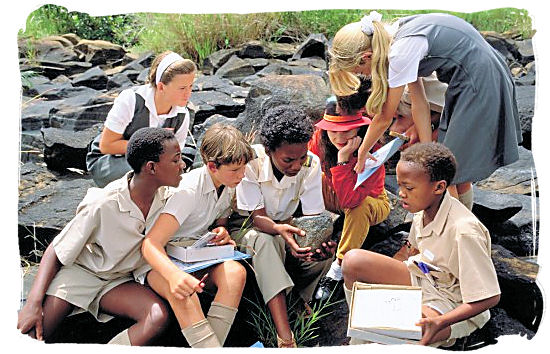
The “future of South Africa” studying the environment - South African education
copyright © South African tourism
Education has been one of the pillars of South Africa’s society right from its beginning. Traditional forms of education were strongly embedded in the cultures of its early inhabitants.
This included oral histories of the tribe, tales of heroism and treachery and practising the skills necessary for survival in a changing and often harsh environment.
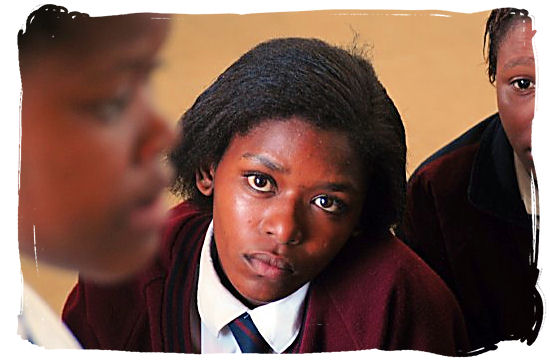
A student’s undivided attention - Education in south Africa
Photograph: Gregor Rohrig
Adults in the Khoi and San communities for example, saw the passing on of cultural history, value and skills within their tribes as one of their main responsibilities.
In the early black communities, especially the Nguni speaking tribes the young men acquired knowledge and skills under the instruction of respected military, religious and political leaders.
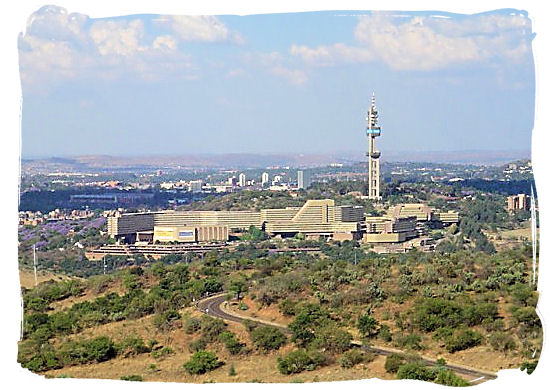
The University of South Africa in Pretoria, one of the world’s largest distance education universities - Education in south Africa
The socialization of women, although sometimes done within age-groups, was more often in small groups of siblings or cousins, and it emphasized domestic and agricultural skills necessary to the survival of the family.
In all of these situations, the transmission of religious values was a vital element of the education process.
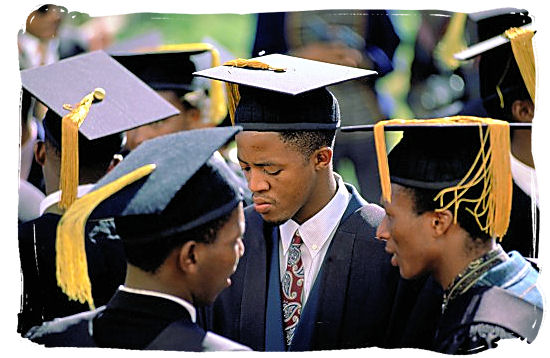
Graduation day - South African education
copyright © South African tourism
It was during the settlement of the Cape Colony in the 17th century that the first more formal European type schools were established by Dutch Reformed Church elders, committed to biblical instruction.
The arrival of the London Missionary Society saw the start of British mission schools, which rapidly increased in number during the early 1800s.
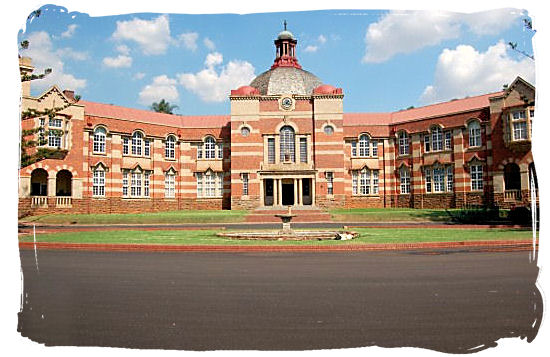
Pretoria boys high school, English medium high school for boys, located in Brooklyn, Pretoria - Education in south Africa
Following the British victory in the South Africa war, thousands of teachers from Britain, Canada, Australia and New Zealand were brought to South Africa, to instil the English language and British cultural values, especially in the two former Afrikaner republics.
To counter the British influence, a group of Afrikaner churches established the Christian National Education program for the Afrikaans speaking population.
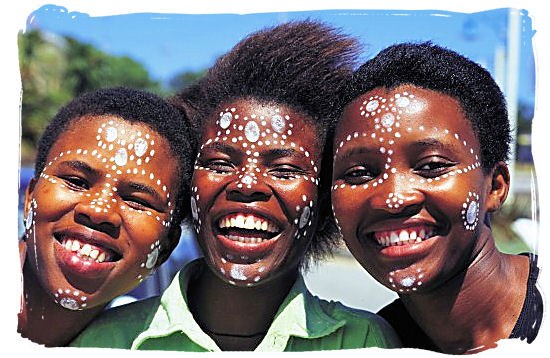
Three happy school girls having fun decorating their faces - South African education
copyright © South African tourism
During the 1980s when the struggle against apartheid reached a peak, black students became committed to destroying the education system. It all started with the compulsory introduction of the “Afrikaans” language.
“Afrikaans” was regarded as the language of the apartheid oppressors, to the curriculums of their schools. This was the spark that ignited student protest actions of enormous proportions.
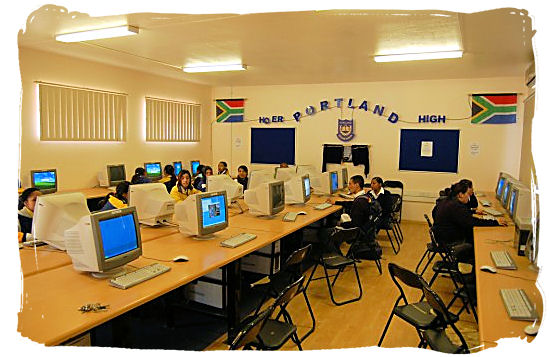
Computer classroom of Portland High at Mitchell's Plain, near Cape Town - Education in south Africa
In present-day’s South Africa the Bill of Rights contained in the constitution, stipulates that everyone has the right to a basic education, including adult basic education and further education.
The State, through reasonable measures, must progressively make this available and accessible by means of the Department of Education, which is overall responsible for education across the country.
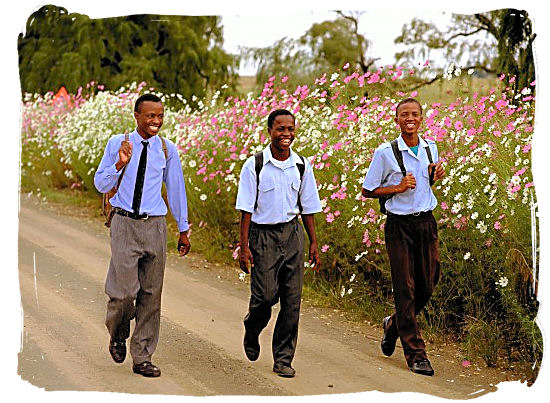
Schoolchildren often have to walk long distances to school in the rural areas - South African education
copyright © South African tourism
Formal education in South Africa is categorised according to three levels;
- General Education and Training,
consisting of the Reception Year (Grade 0) through to grade 9. Under the South African Schools Act of 1996, education is compulsory for all South Africans from age 7 (grade 1) to age 15, or the completion of grade 9.
Further Education and Training,
consisting of grades 10 to 12, the year of matriculation. It also includes career-oriented education and training offered in other further education institutions such as technical colleges, community colleges and private colleges. Diplomas and certificates are qualifications recognised at this level.
Higher Education,
consisting of a range of university degrees, technicon diplomas and certificates up to and including postdoctoral degrees. More then a million students are enrolled in the country's 24 state-funded tertiary institutions: 11 universities, five universities of technology, and six comprehensive institutions.
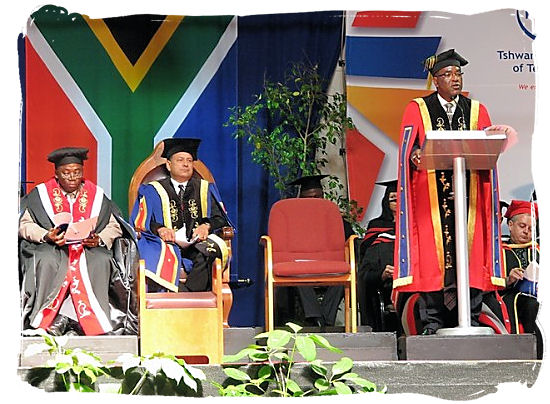
Graduation ceremony at the Tshwane University of Technology - Education in south Africa
copyright © South African tourism
Many of South Africa's universities are world-class academic institutions, at the cutting edge of research in certain spheres.
Although subsidised by the state, the universities are autonomous, reporting to their own councils rather than government.
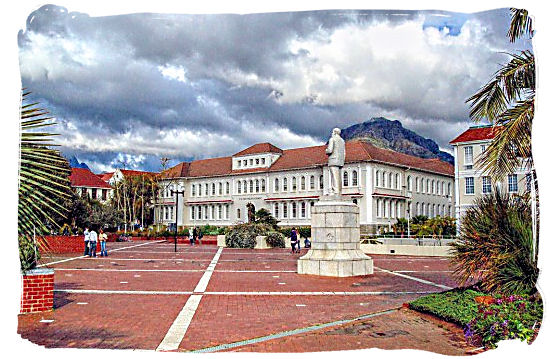
The internationally renown University of Stellenbosch - Education in south Africa
A matriculation endorsement is required for the study of university degrees, with a minimum of three subjects passed at the higher, rather than standard, grade, although some universities set additional academic requirements.
A standard school-leaving South African senior certificate is sufficient for technical qualifications and diplomas.
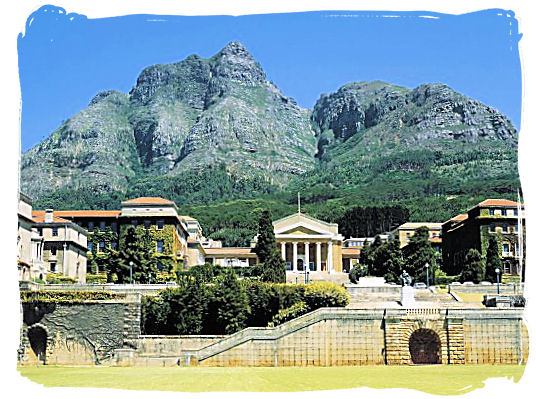
University of Cape Town, located on the Rhodes Estate, on the slopes of Devil's Peak in Cape Town - Education in south Africa
copyright © South African tourism
| |
 |
- Three bands of education
- General and Further Education and Training
- Tertiary education
- Spending and challenges
Three bands of education
South Africa's National Qualifications Framework (NQF) recognises three broad bands of education: General Education and Training, Further Education and Training, and Higher Education and Training.
School life spans 13 years or grades, from grade 0, otherwise known as grade R or "reception year", through to grade 12 or "matric" – the year of matriculation. General Education and Training runs from grade 0 to grade 9.
Under the South African Schools Act of 1996, education is compulsory for all South Africans from the age of seven (grade 1) to age 15, or the completion of grade 9. General Education and Training also includes Adult Basic Education and Training.
| LEVELS OF EDUCATION IN SOUTH AFRICA | |||
| BAND | SCHOOL GRADE | NQF LEVEL | QUALIFICATIONS |
| HIGHER | 8 | Doctors Degree | |
| 7 | Masters Degree | ||
| Honours Degree | |||
| Postgraduate Diploma | |||
| 6 | General first degree | ||
| Professional first degree postgraduate | |||
| Bachelor's degree | |||
| 5 | First diploma | ||
| Higher certificate | |||
| Certificate | |||
| FURTHER | 12 | 4 | Diploma |
| 11 | 3 | Certificate | |
| 10 | 2 | Certificate | |
| GENERAL | 9 | 1 | Grade 9 Adult Basic Education and Training level 4 |
| 8 | |||
| 7 | |||
| 6 | |||
| 5 | |||
| 4 | |||
| 3 | |||
| 2 | |||
| 1 | |||
| R | |||
Source: Department of Education
Further Education and Training takes place from grades 10 to 12, and also includes career-oriented education and training offered in other Further Education and Training institutions – technical colleges, community colleges and private colleges. Diplomas and certificates are qualifications recognised at this level. The matric pass rate, which was as low as 40% in the late 1990s, has improved considerably. A total of 581 573 full-time students and 38 595 repeat students sat the matriculation exams in 2009, 60.6% of whom passed.
Related articles
Education quick links
Government and related sites
- Department of Education
- Thuthong national education portal
- South African Qualifications Authority
- National Qualifications Framework
- Education Association of South Africa
General and Further Education and Training
- SA Schools
- SchoolNet SA
- Independent Schools Association of SA
- SchoolGuide
- Learning Channel Online
- SABC Education
- The Teacher
Tertiary education
South Africa's universities
- Cape Peninsula University of Technology
- Central University of Technology
- Durban University of Technology
- Nelson Mandela Metropolitan University
- North West University
- Rhodes University
- Stellenbosch University
- Tshwane University of Technology
- University of Cape Town
- University of Fort Hare
- University of Johannesburg
- University of KwaZulu-Natal
- University of Limpopo
- University of Pretoria
- University of South Africa
- University of the Free State
- University of the Western Cape
- University of the Witwatersrand
- University of Venda
- Vaal University of Technology
- Walter Sisulu University





 "Study in Italy" is a valuable information tool for students wishing to attend higher education (H.Ed.) programmes in Italy, both at undergraduate and postgraduate level.
"Study in Italy" is a valuable information tool for students wishing to attend higher education (H.Ed.) programmes in Italy, both at undergraduate and postgraduate level. 






